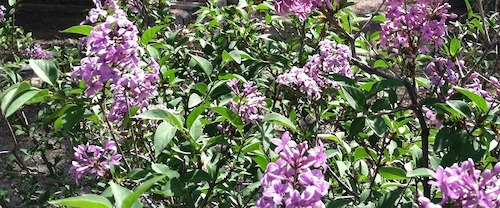The Chronicles Of Grant County
Lilac Street
Lordsburg
 Lilacs growing in Arizona. (The photograph was produced by Jake Weltzin and provided courtesy of the United States Geological Survey.)
Lilacs growing in Arizona. (The photograph was produced by Jake Weltzin and provided courtesy of the United States Geological Survey.)
Lilac Street is a lane in the City of Lordsburg in Hidalgo County. The street was named after the lilac shrub. Some also call the lilac a "bush" or a "tree."
"Lilacs are versatile flowering shrubs, which have a wide range of uses in the home garden," according to information in "Growing Lilacs, Home and Garden Booklet Number 199" issued by the Agricultural Research Service of the United States Department of Agriculture (USDA) in August of 1973 and slightly revised in October of 1977. "They can serve as border plants with smaller shrubs, as corner plantings, as windscreens, or as flowering hedges. Both plants and flowers are very attractive."
"Although lilacs display flowers that are among the most delicate of the ornamentals, the plants are among the most hardy," this booklet continued. "Some varieties can survive winter temperatures of -60° F. They are therefore suited to all parts of the United States except the South, where winters are too mild to provide the plants with the seasonal rest period they need."
The booklet noted that "lilac plants often grow and continue to flower for many years even if totally neglected. Normally, the only care they need is pruning to keep them within bounds. The plants range from 3 feet to as much as 30 feet in height, depending on the age or type grown. Most, however, remain under 10 feet."
The shrubs have flowers that come in a variety of colors.
"Lilac flowers can be white, violet, blue, true lilac, pink, magenta, purple, or variations of these colors," according to the booklet issued by the USDA. "Depending on where you live, and the lilac varieties you choose, lilacs can provide color and fragrance from April through June."
The "Plant Guide" issued by the Natural Resources Conservation Service of the USDA detailed several economic and ethnobotanic uses of the lilac shrub.
"A green dye is obtained from the flowers and the leaves and a yellow-orange dye is obtained from the twigs," detailed this USDA guide referencing information from "Nature's Colors – Dyes From Plants" by Ida Grae in 1974. "An essential oil is obtained from the flowers and used in perfume fragrances."
In addition, this guide from the USDA, referencing information from "Native American Ethnobotany" by Daniel Moerman in 1998, indicated that an ethnobotanic use of lilac shrubs was that "the bark and leaves [have] been chewed as a treatment for [a] sore mouth."
The U S Forest Service defines "ethnobotany" as "…the study of how people of a particular culture and region make use of indigenous (native) plants."
Do you have questions about communities in Grant County?
A street name? A building?
Your questions may be used in a future news column.
Contact Richard McDonough at chroniclesofgrantcounty@mail.com.
If your email does not go through, please contact editor@grantcountybeat.com.
© 2023 Richard McDonough